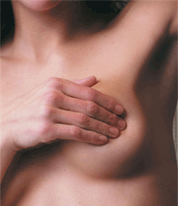Here is a little guide to the detection and signs of breast cancer. You will also find some of the risk factors associated with breast cancer. (July 2003 icon)
CLICK HERE to READ OUR OVERVIEW

Breast cancer is by far the most common cancer in women - with more than 41,300 diagnosed with it every year in the UK. About 300 men a year are also diagnosed with breast cancer. For women, the lifetime risk is now one in nine. Most women are first diagnosed after their menopause, but more than 8,000 are under 50.
Detection of breast cancer : More than 90 per cent of breast tumours are first detected by women themselves. Get to know how your breasts normally look and feel at different times of the month. If you notice a change that isn’t normal for you, talk it over with your doctor. Nine out of 10 breast lumps are benign (not cancerous) and are usually cysts or fibroadenoma (a collection of fibrous glandular tissue).
Apart from lumps, look out for the following signs of breast cancer:
* A change in the size or shape of a breast
* Dimpling of the skin, often called peau d’orange (orange peel) by doctors
* Thickening
* An inverted, turned in, nipple
* A lump or thickening in the nipple
* A swelling or lump in your armpit
* A blood-stained discharge
* A rash on a nipple or surrounding area
You are more at risk if you have a strong family history of breast cancer, carry a breast cancer gene, started your periods early and had a late menopause, have no children or had them late in life, didn’t breast feed for nine months or more, have a history of benign breast disease or have been exposed to large amounts of radiation. Other increased risk factors include smoking, drinking alcohol, being overweight, taking the contraceptive pill, HRT, and a diet high in red meat and fat and low in fibre, fruit and vegetables.

About 300 men a year are also diagnosed with breast cancer

Recently researchers have suggested that we may be able to prevent as much as 35 out of every 100 cancer cases by altering our diets. However, it is difficult to be exact about this. Other researchers have suggested a range of figures from 10 per cent to 70 per cent of cancers preventable by changing diet.
Ed’s note: As we covered in February 2003’s icon centrefold, other factors that have been shown to help include:
- Dense breast tissue is high risk tissue. Women with the highest levels of long chain omega 3 and vitamin A keep their tissue soft and don’t get breast cancer.
- Tocotrienol vitamin E (only available in the USA) linked in a number of studies to reduced risk (sadly tocopherol vitamin E has no effect)
- B complex vitamins can break oestrogen down into harmless oestriol
- Selenium intake is linked to lower risk. Garlic reduces spread
- Phytoestrogens from fruit and especially pulses (lentils, beans, soya and chickpeas) reduce risk.
- US research showed 40% of women who get breast cancer have some vitamin C deficiency even to the point of scurvy.
- Oestrogen mimics abound; and once in your body are sometimes hard to remove. For example, herbicides and pesticides (e.g. Lindane and DDT - still on overseas vegetables); petrol fumes, cleaning agents, volatile organic carbon products, many perfumes, glues and dyes.
- Dairy has been shown to increase the risk of certain cancers and should be avoided.